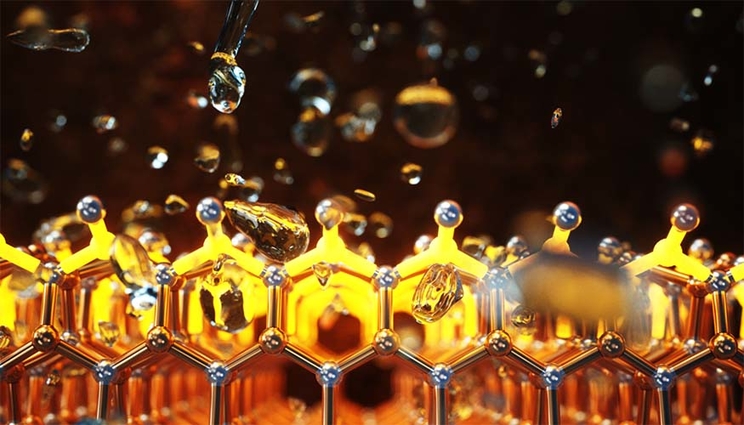Researchers discover unusual property in hydrogen fuel device that could be ultimate guide to self-improvement
 (Download Image)
(Download Image)
Hydrogen gas bubbles evolve from water at a thin layer of gallium oxynitride formed on gallium nitride surfaces. This work demonstrates the chemical transformation of gallium nitride into gallium oxynitride leads to sustained operation and enhanced catalytic activity, thus showing promise for oxynitride layers as protective catalytic coatings for hydrogen evolution. Illustration by Ella Maru Studios.
Three years ago, scientists at the University of Michigan discovered an artificial photosynthesis device made of silicon and gallium nitride (Si/GaN) that harnesses sunlight into carbon-free hydrogen for fuel cells with twice the efficiency and stability of some previous technologies.
Now, scientists at Lawrence Livermore and Lawrence Berkeley national laboratories – in collaboration with the University of Michigan – have uncovered a surprising, self-improving property in Si/GaN that contributes to the material’s highly efficient and stable performance in converting light and water into carbon-free hydrogen. The research, reported in Nature Materials, could help radically accelerate the commercialization of artificial photosynthesis technologies and hydrogen fuel cells.
Materials in solar fuels systems usually degrade, become less stable and as a result produce hydrogen less efficiently, but the team found an unusual property in Si/GaN that somehow enables it to become more efficient and stable.
Previous artificial photosynthesis materials are either excellent light absorbers that lack durability or they are durable materials that lack light-absorption efficiency.
But silicon and gallium nitride are abundant and cheap materials that are widely used as semiconductors in everyday electronics such as LEDs (light-emitting diodes) and solar cells, said co-author Zetian Mi, a professor of electrical and computer engineering at the University of Michigan who invented Si/GaN artificial photosynthesis devices a decade ago.
When Mi’s Si/GaN device achieved a record-breaking 3 percent solar-to-hydrogen efficiency, he wondered how such ordinary materials could perform so extraordinarily well in an exotic artificial photosynthesis device – so he turned to senior author and Berkeley Lab scientist Francesca Toma for help.
HydroGEN: Taking a team science approach to solar fuels
Mi had learned about Toma’s expertise in advanced microscopy techniques for probing the nanoscale (billionths of a meter) properties of artificial photosynthesis materials through HydroGEN, supported by the DOE’s Hydrogen and Fuel Cell Technologies Office. HydroGEN is a national lab consortium led by the National Renewable Energy Laboratory to facilitate collaborations between national labs, academia and industry for the development of advanced water-splitting materials.
Toma and lead author Guosong Zeng, a postdoctoral scholar in Berkeley Lab’s Chemical Sciences Division, suspected that GaN might be playing a role in the device’s unusual potential for hydrogen production efficiency and stability.
To find out, Zeng carried out a photoconductive atomic force microscopy experiment to test how GaN photocathodes could efficiently convert absorbed photons into electrons, and then recruit those free electrons to split water into hydrogen, before the material started to degrade and become less stable and efficient.
They observed 2-3 orders of magnitude improvement in the material’s photocurrent coming from tiny facets along the “sidewall” of the GaN grain. The material also had increased its efficiency over time, even though the overall surface of the material didn’t change that much.
To gather more clues, the researchers recruited scanning transmission electron microscopy (STEM) at the National Center for Electron Microscopy in Berkeley Lab’s Molecular Foundry, and angle-dependent X-ray photon spectroscopy (XPS).
Those experiments revealed that a 1 nanometer layer mixed with gallium, nitrogen, and oxygen – or gallium oxynitride – had formed along some of the sidewalls. A chemical reaction had taken place, adding “active catalytic sites for hydrogen production reactions,” Toma said.
Density functional theory (DFT) simulations, carried out by co-authors Tadashi Ogitsu and Anh Pham at LLNL confirmed their observations. “By calculating the change of distribution of chemical species at specific parts of the material’s surface, we successfully found a surface structure that correlates with the development of gallium oxynitride as a hydrogen evolution reaction site,” Ogitsu said. “We hope that our findings and approach – a tightly integrated theory-experiments collaboration enabled by the HydroGEN consortium – will be used to further improve the renewable hydrogen production technologies.”
Looking ahead, Toma said that she and her team would like to test the Si/GaN photocathode in a water-splitting photoelectrochemical cell, and that Zeng will experiment with similar materials to get a better understanding of how nitrides contribute to stability in artificial photosynthesis devices – which is something they never thought would be possible.
“It was totally surprising,” Zeng said. “It didn’t make sense – but Pham’s DFT calculations gave us the explanation we needed to validate our observations. Our findings will help us design even better artificial photosynthesis devices.”
This work was supported by the HydroGEN Advanced Water Splitting Materials Consortium, established as part of the Energy Materials Network under DOE’s Office of Energy Efficiency and Renewable Energy.
Contact
 Anne M. Stark
Anne M. Stark
[email protected]
(925) 422-9799
Related Links
Nature MaterialsThis Hydrogen Fuel Machine Could Be the Ultimate Guide to Self-Improvement
HydroGEN
Tags
Advanced Materials and ManufacturingMaterials Science
Physical and Life Sciences
Featured Articles







